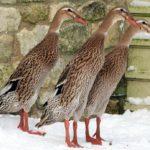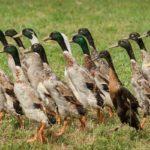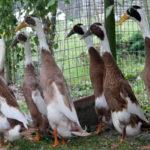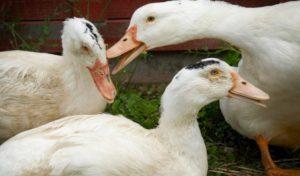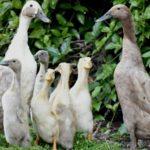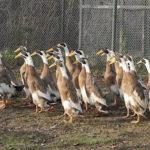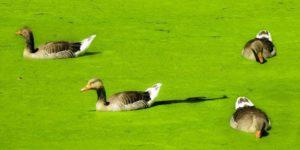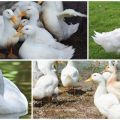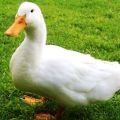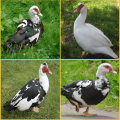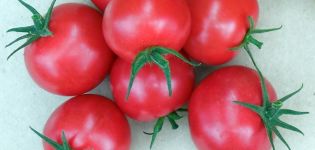Description of Indian Runner ducks, their diseases and breeding rules
Among the duck breeds that can be grown at home, you can find completely unusual varieties. The Indian runner duck can be distinguished from ordinary representatives of the duck family at first glance, its appearance is so characteristic. Consider the description of the breed, history of origin, pros and cons, features of the content, feeding diet and breeding rules.
History of the origin of the breed
Indian runner ducks are an ancient breed, it is believed that it is more than 2 thousand years old. All this time they were bred in Southeast Asia. Only in the 19th century did the runners come to Europe, to the territory of Russia - in the 20th century. At first they were called penguin ducks, but then they were given their modern name - Indian Runner (Indian Runner). In the Krasnodar Territory, a variety has been developed based on this breed and Chinese Peking ducks. She was named the Kuban duck.
The appearance and characteristics of Indian runners
By the breed standard, they have a narrow, cylindrical body, set almost vertically. In this way they look like penguins. The chest and sides are rounded, the abdomen is voluminous, but does not sag, the back is convex. The head is small, the beak is wedge-shaped, long. The neck is straight, thin, in relation to the body it takes 1/3 part. Paws are orange, set like those of penguins. The wings are pressed to the body, the tail is short, slightly raised. The plumage is white, black, brown, brown with specks, reminiscent of wild colors, trout and blue.
These birds are active, mobile, run fast and are timid. The breed belongs to the egg orientation, it is bred to obtain eggs. During the season, the female can lay 150-360 eggs weighing 68-80 g. The color of the shell is from white to olive. Egg production begins at the age of 5-6 months.
Main pros and cons of content
Despite this, there is a steady demand among poultry farmers for ducklings, adult birds and breeding eggs.
The nuances of maintenance and care
Despite the exotic origin and remarkable appearance, Indian runners are not picky and do not require special conditions of detention. They live well in an ordinary poultry house, but it should be spacious, protected from wind and drafts.
The runners' ability to tolerate cold allows them to be kept in an unheated barn, but only if the winter isn't too cold. It should be borne in mind that if you keep the bird in a cold shed in frost, egg production will drop to 12-13 tens. To get a lot of eggs, you need to keep the ducks in a warm and bright room. If necessary, the house should be heated and illuminated up to 12-14 hours a day.
Next to the main room, you need to equip a walk, where to release the bird every day. Place a trough with water for bathing, feed with grass or aquatic vegetation.

Drawing up a diet
If you keep Indian runners in a pasture, where they can find pasture, for example, grass, grain, insects, worms, then you can feed them 1 time a day, and not 2-3, as usual. When kept in a pond, you can not feed at all. Ducks eat wet mash, various types of grains, grains and legumes. They eat grass, young dandelions, tops of root crops, greens from the garden.
They can be given table scraps, boiled vegetables and root vegetables. Add chalk, salt, crushed shell or premixes. Indian runners can be fed with compound feed.
Breeding rules
For 1 drake, you need to pick up 5 females. Naturally, they must be purebred in order for the offspring to inherit the characteristic form of the body. Parents of future ducklings should be large, healthy, properly built, without defects in the exterior. Puberty in ducks occurs at 5-6 months, egg fertilization is 88%.
Eggs can be placed on the female (8-10 eggs due to its small size) or sent to the incubator. The incubation of ducklings of this breed takes place in the same conditions as for other breeds. The hatchability percentage is never less than 80, when hatching a duck - 90%.
Ducklings appear on the 28-31 day of incubation. They differ in survival rate, grow rapidly. The first month they are kept in a brooder, under a lamp that illuminates and warms. They are fed first with cottage cheese, eggs, then finely crushed grain and chopped grass are added. After a month of growing in a brooder, young ducklings are transferred to the poultry house.
Runners are so named because they are mobile and love to run. If you let them out into the yard, they will rush around it in a whole flock. Ducks are hardy, do not get tired of looking for food. If they get into the garden, they can spoil the planted. Ducks do not feel discomfort in the pen if it is spacious. It should contain bathing water, with which the birds will keep their plumage clean. In the absence of bathing, females can reduce egg production, become restless.
By external signs, you can determine the sex of the ducklings of Indian runners, if it is necessary for fattening or breeding. You can distinguish a young drake from a duck by the shade of plumage and legs. In females, they are lighter. In 2-3-month-old drakes, the tail feathers curl upward. You can determine the sex of the Indian runner and the sound emitted: females quack, males hiss.

Frequent illnesses
Indian runners are in good health. They have good immunity, successfully resisting diseases. There are no typical diseases that are inherent in Indian runners. But young animals can be susceptible to hypovitaminosis, as a result of which the ducklings become weak, painful, and depressed. In adult females, cloacitis may develop during egg production. This is an inflammation of the mucous membranes of the oviduct and cloaca, the cause is a lack of nutrients.
Indian runners will be less sore if kept on a clean bed, and fed from clean feeders and drinkers.From the feeders you need to remove the remnants of food every day, rinse and dry them, pour clean water into the drinkers. Disinfect once a month.
Do not allow ducklings to live crowded. For 1 sq. m. house is allowed to place no more than 6-8 birds. Be sure to walk the ducks, do not keep them in the barn all the time. On the street, even in the pen, they move a lot, can find something tasty, are illuminated by the sun's rays.
Indian runners are an ancient breed that is still bred today. Besides attractive and funny appearance, they have qualities that are appreciated by poultry farmers. They carry a lot of eggs, which is considered an advantage for a medium-sized duck, they grow quickly, they do not require a lot of food.
